Install Procedure
Getting Started
After a few seconds, the installation program is launched.
If the installation program does not launch automatically:
- Click the Start button on the Windows task bar, and then click Run.
- Browse to the installation disc drive, select Setup.exe, click Open, then click OK.
NOTES
-
If remotely installing to other physical nodes of the cluster, ensure you mount the software installation disc on a UNC path or a shared location (e.g., \\machine_name\shared_directory_name).
NOTES
- This screen will only appear when the bAllow32BitInstallOn64Bit registry key has been created and enabled on this computer.
NOTES
- The options that appear on this screen depend on the computer in which the software is being installed.
Click Next to continue, if no other applications are running.
Click OK to continue, if virus scanning software is disabled.
Click Next to continue.
Cluster Selection
Click Next to continue.
NOTES
- You will only see this screen if you are installing the CommServe software onto a physical node, and the CommServe database on the virtual server.
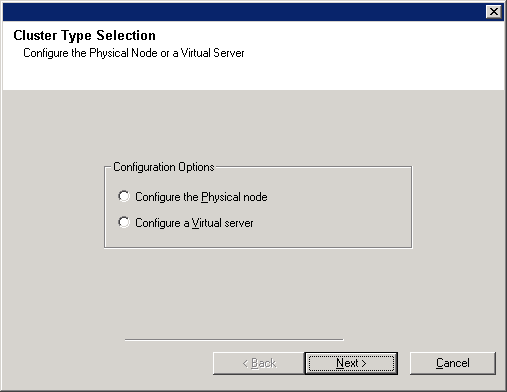
Click Next to continue.
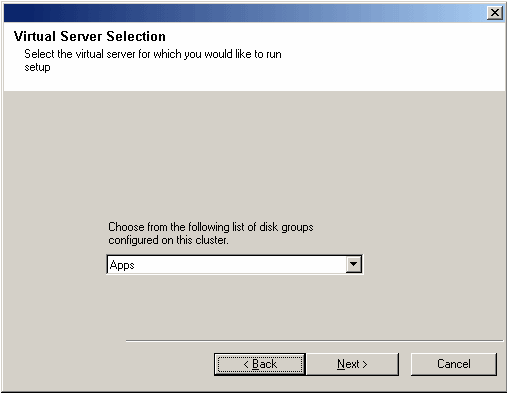
Select Components for Installation
NOTES
- Your screen may look different from the example shown.
- Components that either have already been installed, or which cannot be installed, will be dimmed. Hover over the component for additional details.
- The Special Registry Keys In Use field will be enabled when GalaxyInstallerFlags registry keys have been enabled on this computer. Hover over the field to see which keys have been set, as well as their values. For more information, see Registry Keys.
Click Next to continue.
To install the CommServe expand the CommServe Modules folder and select the following:
- CommServe
If you are installing the CommServe software on a physical node, the CommCell Console will be selected by default.
If you are installing the CommServe software on a virtual server, the CommCell Console will be not selected, as it is not supported on a virtual server.
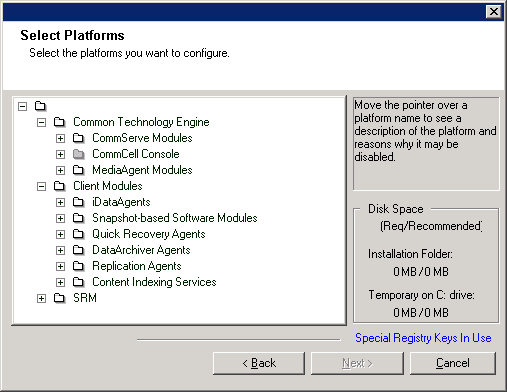
NOTES
- Follow the on-screen prompts for installing the Microsoft .NET Framework package.
- If you are prompted to install the Service Pack for the Microsoft .NET Framework, click Yes.
- This prompt is displayed only when Microsoft .NET Framework is not installed.
- Once the Microsoft .NET Framework is installed, the software automatically installs the Microsoft Visual J# 2.0 package.

Set Up the Required Privileges
NOTES
- This option will only appear if the Windows user account used to install the software does not have the required administrator rights (e.g., if the operating system was newly installed).
- If you choose to click Yes, the install program will automatically assign the required rights to your account. You may be prompted to log off and log back on to continue the installation.
- If you choose to click No, the installation will be aborted.
- You will be prompted at the end of the installation to decide if you want these privileges to be revoked.
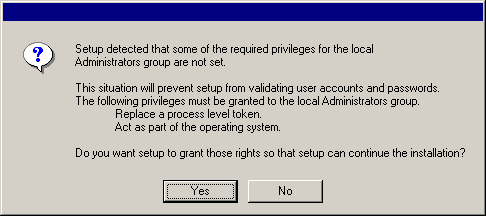
- Right to increase quotas (this is referred to as adjust memory quotas for a process on Windows Server 2003).
- Right to act as a part of the operating system.
- Right to replace a process level token.
Configuration of Other Installation Options
NOTES
- This is the password for the administrator's account that was created prior to this installation.
Click Next to continue.
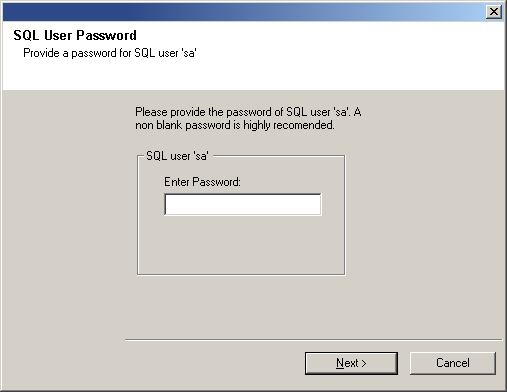
NOTES
- Do not install the software to a mapped network drive.
- Do not use the following characters when specifying the destination path:
/ : * ? " < > |
It is recommended that you use alphanumeric characters only. - If you intend to install other components on this computer, the selected installation directory will be automatically used for that software as well.
- If a component has already been installed, this screen may not be displayed if the installer can use the same install location as previously used.
-
If you intend to use the SnapProtect™ feature for Windows File System iDataAgent, the agent should be installed on a non-system drive and not a filer volume.
Click Browse to change directories.
Click Next to continue.
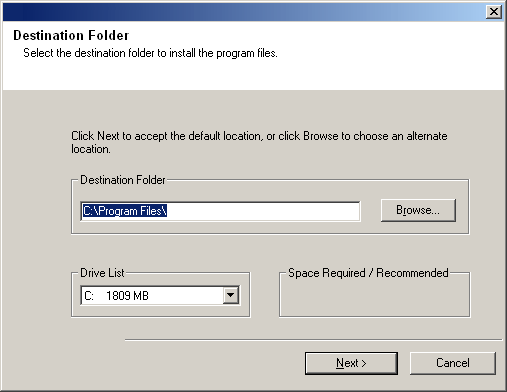
After installing to a proprietary disk resource, the error message CVD failed to set dependency may be generated. To set the dependency, open the Cluster Administrator and select the CVD that has just been installed. Click on the Properties Dependencies tab, and click Modify. Select the proprietary disk resource and click OK.
Do not select the same destination drive in which the MSCS resides.
Firewall Configuration
- If this Client communicates with the CommServe Server and/or MediaAgent across a firewall, select Yes, configure firewall services, and then click Next to continue. Proceed to the next Step.
- If firewall configuration is not required, click No, do not configure firewall services and then click Next to continue. Proceed to the next section.
NOTES
- Operating systems, such as Windows 2008 and Windows Vista, may have more than one profile present. When you select No to configure firewall services, verify that firewall settings are not enabled in the profile(s).
- If the system detects firewall settings are present in the profile(s),
you must select from the following:
- Disable firewall for ALL profiles: Employ caution when choosing this option; firewall settings will be disabled in all profiles. This requires a system reboot; installation automatically resumes after reboot.
- No, Firewall is not enabled: Select this option if your
firewall settings allow communication with the CommServe computer.
Click Back to configure firewall services.
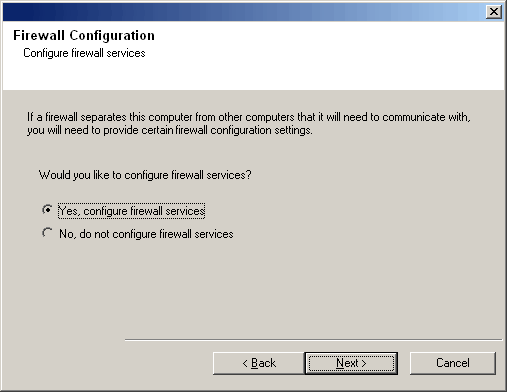
For all one-way firewalls allowing incoming connections and those one-way firewalls allowing outgoing connections without additional port filtering, skip this step.
Click Next to continue.
NOTES
- Consider the following:
- On the CommServe Server, this list should include all the MediaAgents and Clients that are on the other side of the firewall.
- On the MediaAgents/Clients this should include the CommServe computer, and any other Clients/MediaAgents on the other side of the firewall with which communications will be established.
- For each machine on the other side of the firewall that you want to
configure, choose the type of firewall configuration based on the firewall setup in
your environment. Choose from the following options:
- Click on 2-way firewall if you can open certain ports as bi-directional ports.
- Click 1-way firewall; host is reachable from this machine on the machine that is on the secure side of the firewall.
- Click 1-way firewall; host is NOT reachable from this machine on the machine that is on the public / DMZ side of the firewall.
- If you wish to communicate with computers in a clustered environment, ensure that you add the Host Name/IP Address of all physical nodes in the cluster (even if no CommCell components are installed) and all the virtual nodes in which CommCell components are installed.
- Type the host name or the IP address and the GxCVD port number of the host name, and click Add to place it in the Host Name/IP Address List.
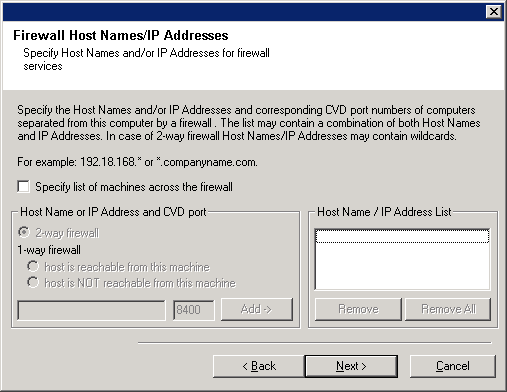
If firewall separating this computer from others allows incoming connections, but these connections can be made only on a limited set of ports, then configure the appropriate port range here. For all other scenarios, skip this step.
Note that if you do not specify hostname(s) as well as port number(s), then the firewall services will not be configured.
NOTES
- Typically in a two-way firewall, the open ports must be indicated for all computers. In a one-way firewall, the ports must be specified on computers in the open side, if they are open in a restricted way. Note that the port ranges are not required for computers that are fully closed in the one-way firewall. For example, laptops which are configured as clients in the Workstation Backup Agent.
- In a clustered environment, make sure the firewall ports specified here are open for communication on all the physical nodes as well as the virtual nodes.
Click Next to continue.
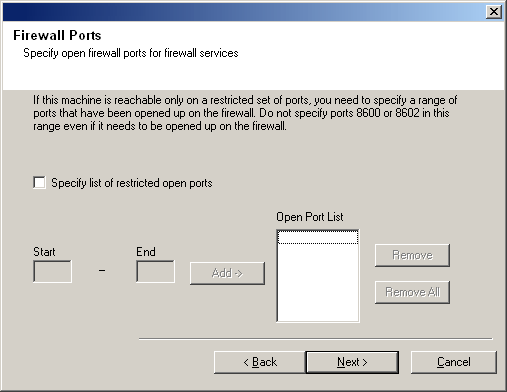
Click Next to continue.
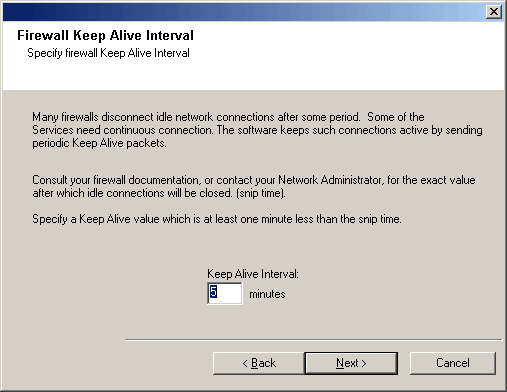
Click Next to continue.
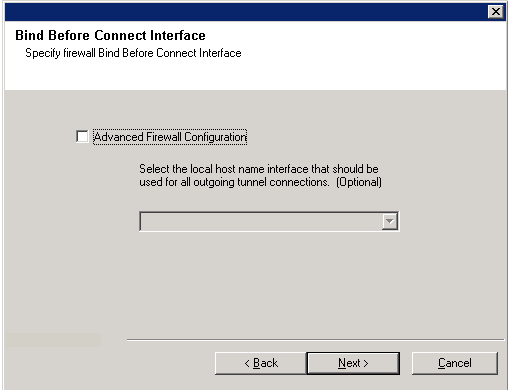
Click Next to continue.
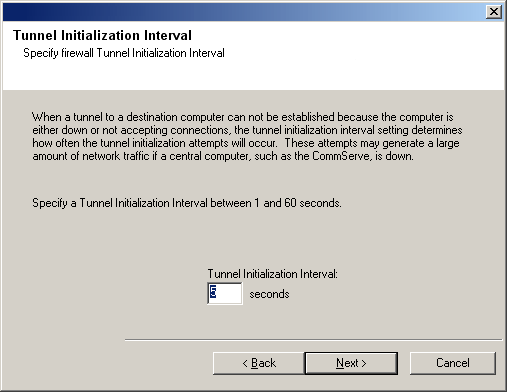
|
|
If any of the above prompts for firewall configuration is not displayed, you must configure communication across firewall(s) using the Firewall Configuration Wizard before running any operations on this computer. (See Configure or Modify Firewall Settings on Windows Computers for step-by-step instructions on using the Firewall Configuration Wizard.) |
NOTES
- Do not specify a mapped network drive.
- You can either accept the default or select a different location on a local disk drive. However, you must ensure that the drive has at least 1GB of free space.
- The directory file path selected should not be located on a FAT drive. A FAT drive cannot be supported as the location for this database because it does not allow a temporary sparse file to be generated when creating the database snapshot, which is required for data verification.
- If the default metadata database directory is low in disk space, provide a path that is not associated with another application.
Click Browse to change directories.
Click Next to continue.
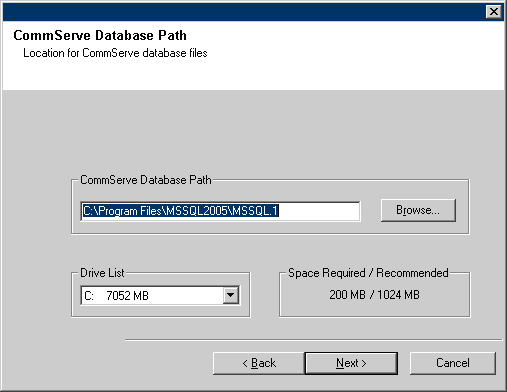
NOTES
- The CommServe client name is the name of the computer. This field is automatically populated.
- The CommServe host name is the TCP/IP network interface name of the CommServe computer. This field is automatically populated.
- Do not use the following characters in the CommServe client name or the
CommServe host name:
\|`~!@#$%^&*()+=<>/?,[]{}:;'"
Click Next to continue.
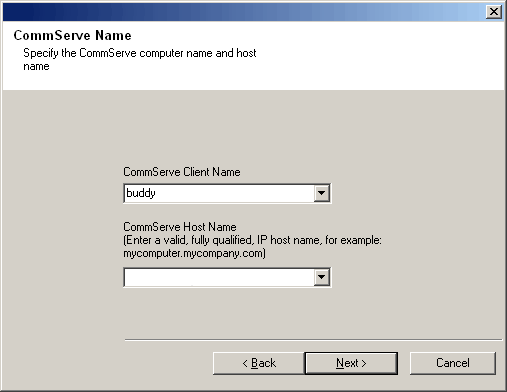
NOTES
- For cluster, specify a shared drive.
- If you selected Use Network Path, you must enter the Network
share username and the Network share password.
- The Network share username is the domain\username of the user that has administrative rights to the Disaster Recovery Backup destination path.
- The Network share password is the password of the network share username.
Click Next to continue.
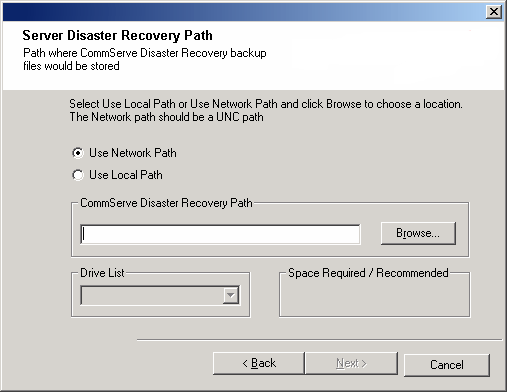
Set User Names and Passwords
NOTES
- The CommCell username and password will be used by the Administrator user to log on to the CommCell Console. This user is automatically created during installation and, by default, has the necessary capabilities to perform all functions. Additional CommCell users with the same or less security rights can be created after the installation of the software.
Click Next to continue.
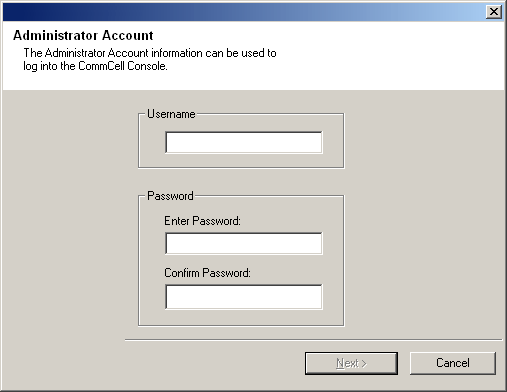
NOTES
- This password is used to protect unauthorized data access from media used by the system.
- If you choose to password protect your media, it is essential that you record this password. In certain disaster recovery scenarios, it may be necessary to read your backup data directly from the backup media (using Media Explorer, for example). This password will be required to directly access the media.
Click Next to continue.
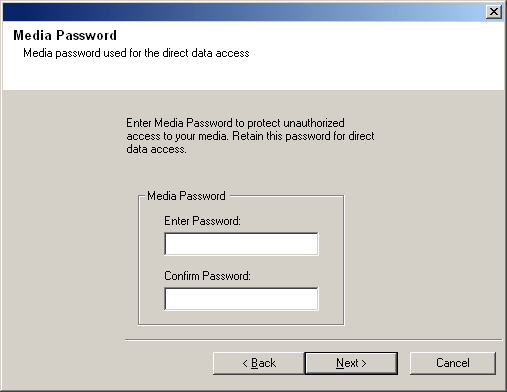
- Type the location of the client's job results directory, or click Browse.
NOTES
- The Agent uses the job results directory to store the client's backup and restore job results.
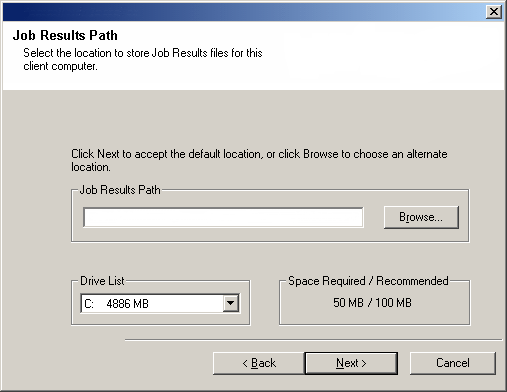
Configure the CommCell for Web-Based Administration
NOTES
- The Internet Information Server (IIS) must be installed on this computer in order to configure for web administration.
- Configuring this computer for web administration allows you to:
- Access the CommCell Console and Books Online from a remote computer using a Web browser.
- View CommCell reports via a Web browser.
- Access Books Online by clicking the Help button (the icon with a ?) in the CommCell Console.
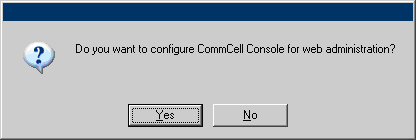
NOTES
- If the alias already exists, you will be informed that the alias is already in use. Click Yes to overwrite the alias, and then click OK.
Click Next to continue.
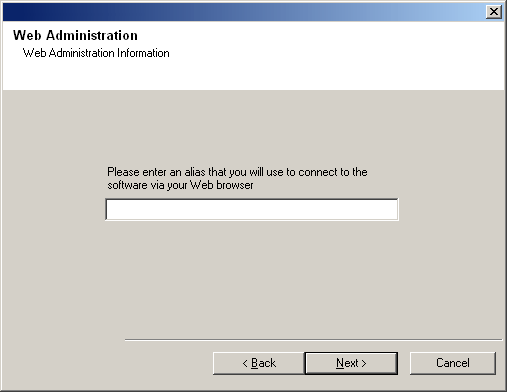
NOTES
- Internet connectivity is required to download updates.
- This step is applicable when installing on the first instance.
- Updates are downloaded to the following directory:
<software installation>/Base/Temp/DownloadedPacks.
They are launched silently and installed automatically for the first instance.
Click Next to continue.
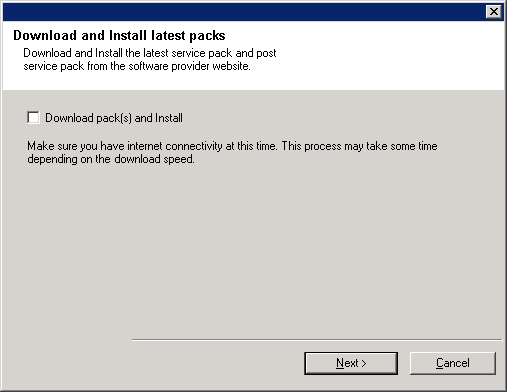
Verify Summary of Install Options
NOTES
- The Summary on your screen should reflect the components you selected for install, and may look different from the example shown.
Click Next to continue or Back to change any of the options.
The install program now starts copying the software to the computer. This step may take several minutes to complete.
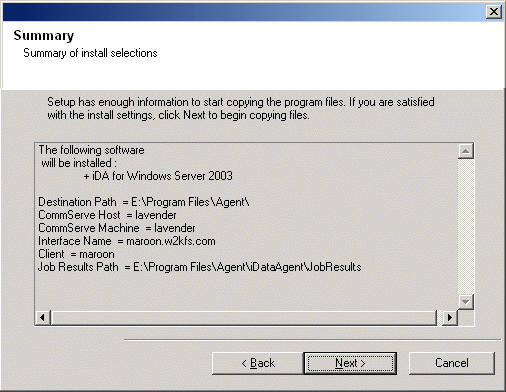
- Skip Reboot
This option will be displayed if the install program finds any files belonging to other applications, that need to be replaced. As these files are not critical for this installation, you may skip the reboot and continue the installation and reboot the computer at a later time. - Reboot Now
If this option is displayed without the Skip Reboot option, the install program has found files required by the software that are in use and need to be replaced. If Reboot Now is displayed without the Skip Reboot option, reboot the computer at this point. The install program will automatically continue after the reboot. - Exit Setup
If you want to exit the install program, click Exit Setup.
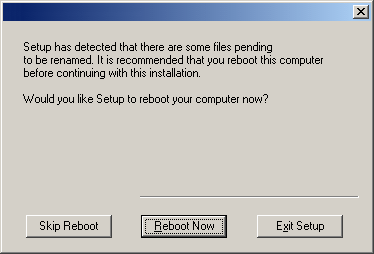
Schedule Automatic Update
NOTES
- Automatic Updates Schedule allows automatic downloading of software updates on a single or weekly basis.
- If you do not select this option, you can schedule these updates later from the CommCell Console.
Click Next to continue.
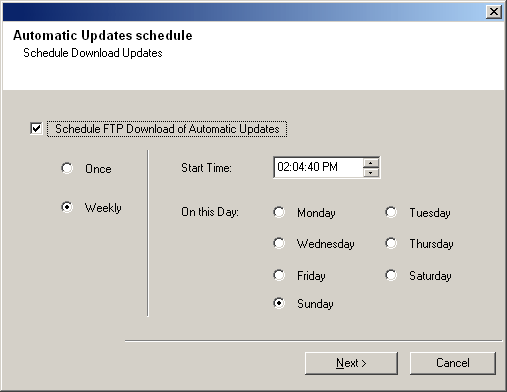
NOTES
- This prompt will only be displayed if the Schedule FTP Download of Automatic Updates option was enabled.
Click Next to continue.
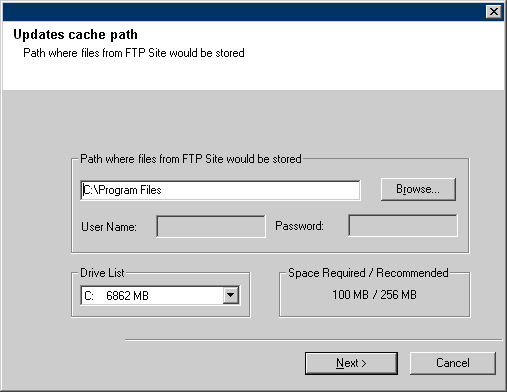
NOTES
- Install Updates Schedule allows automatic installation of the necessary software updates on the computer on a single or weekly basis. If you do not select this option, you can schedule these updates later from the CommCell Console.
- To avoid conflict, do not schedule the automatic installation of software updates to occur at the same time as the automatic FTP downloading of software updates.
- You may be prompted to reboot the computer before restarting services.
-
If a component has already been installed, this screen will not be displayed; instead, the installer will use the same option as previously specified.
Click Next to continue.
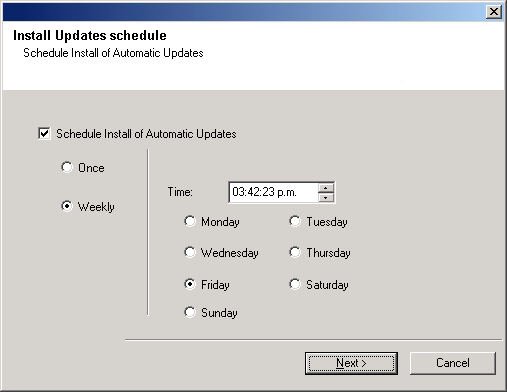
Install Remaining Cluster Nodes
To complete the install for this node only, click No.

NOTES
- The list of Preferred Nodes displays all the nodes found in the cluster; from this list you should only select cluster nodes configured to host this virtual server.
- Do not select nodes that already have multiple instances installed. For more information, see Multi Instancing.
When you have completed your selections, click Next to continue.
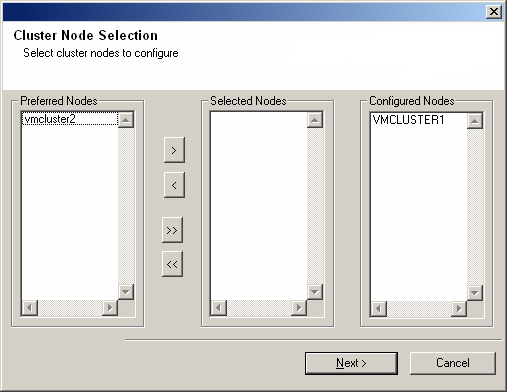
Click Next to continue.
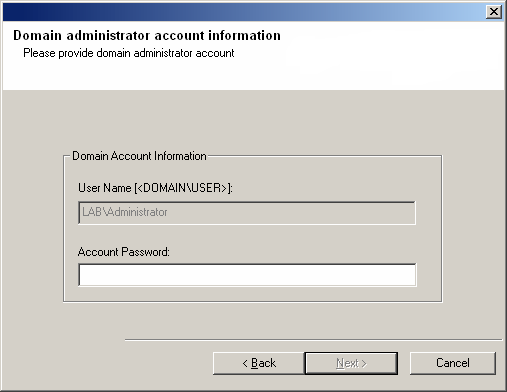
Click Stop to prevent installation to any nodes after the current ones complete.
Click Advanced Settings to specify any of the following:
- Maximum number of nodes on which Setup can run simultaneously.
- Time allocated for Setup to begin executing on each node, after which the install attempt will fail.
- Time allocated for Setup to complete on each node, after which the install attempt will fail.
NOTES
- If, during the remote install of a cluster node, setup fails to complete or is interrupted, you must perform a local install on that node. When you do, the install begins from where it left off, or from the beginning if necessary. For procedures, see Manually Installing the Software on a Passive Node.
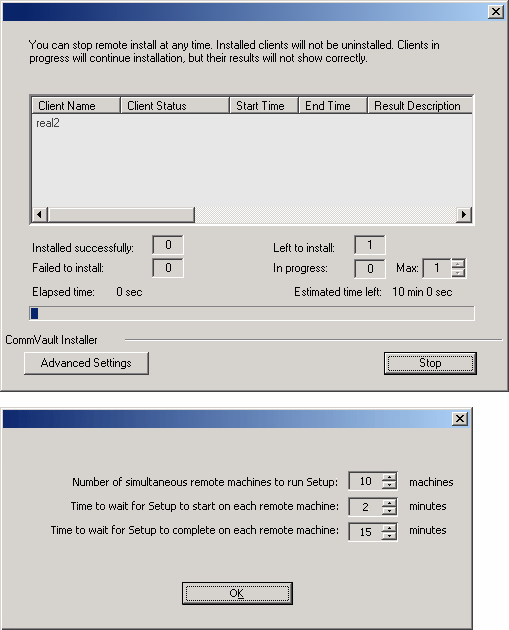
NOTES
- If any node installation fails, you must manually install the software on that node once the current installation is complete. (See Manually Installing the Software on a Passive Node for step-by-step instructions.)
- The message displayed on your screen will reflect the status of the selected nodes, and may look different from the example.
Click Next to continue.
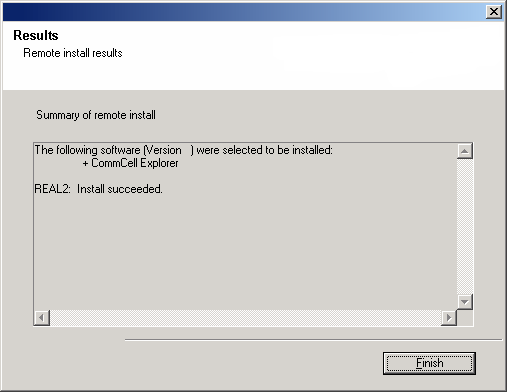
Remove the Required Privileges
NOTES
- This option will only be displayed if you were prompted to assign the privileges earlier in the installation.
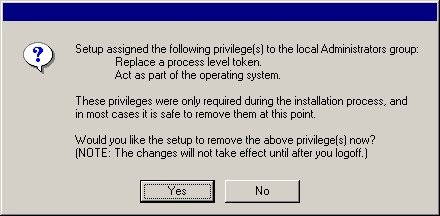
Setup Complete
NOTES
- If any node installation fails, you must manually install the software on that node once the current installation is complete. (See Manually Installing the Software on a Passive Node for step-by-step instructions.)
- The message displayed on your screen will reflect the status of the selected nodes, and may look different from the example.
Click Next to continue.
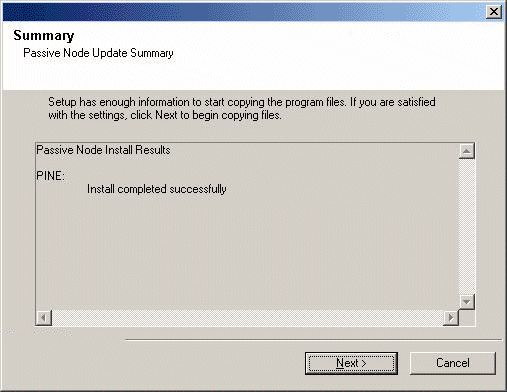
NOTES
- The Setup Complete message displayed on your screen will reflect the components you installed, and may look different from the example shown.
- If you install an Agent with the CommCell Console open, you need to refresh the CommCell Console (F5) to see the new Agents.
- If Reboot Now button is displayed make sure to reboot the computer before performing any other operations from the computer.
Click Finish to close the install program.
The installation is now complete.
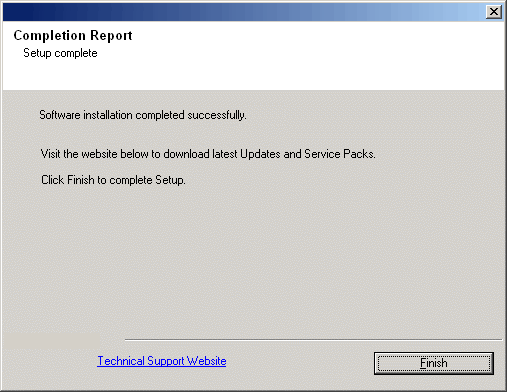
- If you installed both the CommServe software and the CommServe
database to the virtual server:
- If the passive node was not available while installing the software, you must manually install the software on the passive node now. (See Manually Installing the Software on a Passive Node for step-by-step instructions.)
- Fail over the disk group containing the CommServe to the passive nodes at least once, so that the configurations to the passive node occur. This must be done before installing any other software components. The install program updates the passive nodes on the cluster so that the virtual server can fail over. A program to create the CommServe Data Source Name (DSN) is launched automatically on each passive node.
- Fail back the nodes, then continue on to the MediaAgent installation.
- You must install the CommCell Console on a physical node of the cluster before proceeding. For instructions, see Install the CommCell Console - Windows.
- If you installed the CommServe software on the active physical node, and the SQL database resides on the virtual server, you must now install the CommServe software on every passive node as well. For step-by-step instructions, see Manually Installing the Software on a Passive Node.
Post-Install Considerations
General
- If you have a permanent license, open the CommCell Console and apply the license. See Update License for step-by-step instructions.
-
Install post-release updates or Service Packs that may have been released after the release of the software. Alternatively, you can enable Automatic Updates for quick and easy installation of updates in the CommCell® console.
-
After installing the CommServe® or MediaAgent software, it will be listed as a client computer in the host computer's CommCell Browser. The alert icon preceding the CommServe or MediaAgent client computer in the CommCell Console indicates that agent software must be installed on that computer for it to be utilized as a client.
Database Engine
-
Microsoft SQL Server 2005 Enterprise Edition (with Service Pack 2) will be automatically installed while installing the software. Later versions of the Service Pack, if available, are also supported.(* See Disclaimer below.)
If necessary, download and install the latest version of the Microsoft SQL Server service pack and/or post-release updates after an install or upgrade.
- After installing the CommServe, the Default or Named instance created by the SQL Server install requires specific settings. In the Memory tab, the dynamically configured Maximum memory should be 50% of the physical memory available in the CommServe machine. The Memory tab is located in the Properties screen for the Default or Named instance, and is accessible from the SQL Server Management Studio.
CommCell Console
- On Windows 2000 computers, if you wish to Run the CommCell Console as a Remote Web-Based Application, you must manually restart the IIS services on the computer, before launching the CommCell Console from a remote computer.
Cluster/Firewall
If the CommServe is configured to communicate across a firewall, the following firewall related files must be manually copied from the active node to all the passive nodes:- <software installation path>/<software installation folder>/Base/FwHosts.txt
- <software installation path>/<software installation folder>/Base/FwPeers.txt
- <software installation path>/<software installation folder>/Base/FwPorts.txt
If for some reason the passive node is currently active, make sure to stop and restart Services after copying the files.